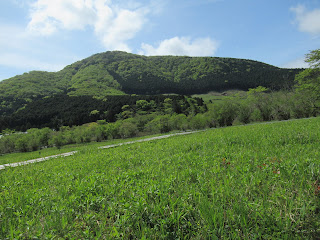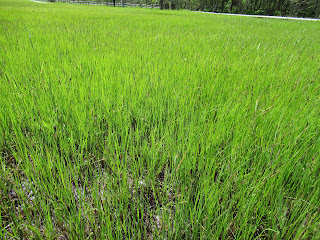 |
| At the entrance |
Before entering the Forest, please check a house on your right. It is a café named Forest Café and a gallery for local artists. I’ve been there during this Golden Week Thursday, but the place was reserved for a private party. We could not try the place. Actually, not only we but also several other groups were turned down the entry due to the event, which means the place is popular. If you have a chance, it would be a nice place for lunch, especially with organic local veggies. (It’s closed for Wednesdays and Thursdays.)
 |
| Forest Café |
At the entrance of the forest, you find a narrow pedestrian road going down rapidly towards Kuzuha River 葛葉川. This is a characteristic feature of Kuzuha Greenery. Basically, Hadano 秦野 is a basin which is an alluvial fun created by several rivers running down from Tanzawa Mountains. Before, Kuzuha River took a straighter route running down from the slope of Mt. Ninotoh (ASL 1144m) 二ノ塔. About 60 thousand years ago the plate tectonics of crashing Philippine and North American plates pushed up the land mass of present-day Oiso Hill 大磯丘陵 that was/is on the Philippine Plate. The alluvial fan north of Oiso Hill received huge pressures and several faults were created like creases of linen. At least 3 fault lines, Hadano 秦野, Shimojuku 下宿, and Mitsuya 三屋 lines crossing Kuzuha River were activated and created waterfalls. The upper stream of each fall had a gentler slope where water ran slower. It meandered in the alluvial fan and eroded the riverbed until the fall disappeared when the inclination of the riverbed reached the degree of pre-tectonic change. In this way, the valleys have become deeper as it went down near to the point of a gone waterfall. Inevitably, From the Forest entrance to the river, the pedestrian road is rapidly going for approximately 30m down.
Going down, we meet a cozy garden with a mixture of native and imported flowering trees. When we stroll along the path, we soon meet Kuzuha House that is an admin office cum meeting place for locals. You enter the house and pick up several info leaflets. Oh, some of them are also downloadable from their HP here. The staff of the House is kind and friendly. They also know the latest about the Forest. Er … speaking of the “latest,” Kuzuha Greenery is in the process of recovery from the devastations due to storms in recent years. In addition, oak tree wilt is rampant and killed several large oaks in the Forest. So, as of May 2023, the path to upper stream of Kuzuha River where fireflies dance in late May to early June is closed for safety concerns + rejuvenation of firefly population. By the same reason, the access to lower stream of the River within the Greenery is also closed. Consequently, the place we can enjoy now is about ½ of Kuzuha Greenery. Having said that, the place has lots of places with richness of living creatures + the planet earth.
 |
| Inside the Kuzuha House where community can gather. |
 |
| They also have a small natural museum. |
The Kuzuha Greenery is managed to control different environment among the spots. The place we enter via a steep slope intentionally leaves local trees and some lower shrubs some of which are introduced. Relatively speaking, its floor is wetter and tends to receive less sunlight. The ground herbaceous are those that love such environment. On the left of Kuzuha House to the upper stream direction, there is an open space named Camphor Tree Space. It has several picnic benches that are popular for weekend picnics. The space is surrounded by large trees, some of them are imported variety. The number of trees is smaller than the garden we came from. The floor has more sunlight, and so, the place has the herbs for drier places such as sedges. We can enjoy such difference in just 10 or so meters apart. That’s fun. In front of Kuzuha House, there is a suspension bridge called Kuzuha Suspension Bridge くずはのつり橋. Let‘s walk this to cross Kuzuha River. The other side has more “wild” atmosphere that would reflects less human intervention. Going straight from the bridge and we enter residential area surrounding the Greenery. Today let’s turn right from the bridge to go down the steps. We’ll meet another special feature of Kuzuha Greenery.
 |
| After
descending the slope, we enter such cozy path to Kuzuha House. |
 |
| Camphor
Tree Space. Could you see the difference from the above photo? |
 |
| Kuzuha Suspension Bridge |
 |
| The
other side is like this. I guess we’ll see a spectacular autumn colors here ... |
 |
| In early May, the step was adorned by Pourthiaea villosa. |
We go down the steps and arrive at the bank of Kuzuha River. Unless the weather is bad, the River is, frankly, small. There are several points whose water depth is probably less than 20cm. Though, the valley is deep. That‘s the result of plate tectonics. Both side of the river has steep slope, or cliff where vegetations cling to. We walk a couple of minutes from the end of the steps, and on our left we find a large geological formation with plates attached. That‘s special for Kuzuha Greenery. This is one of the few places where we can observe natural cross section of Hadano Basin 秦野盆地. The bottom is named Kuzuha-dai Gravel Layer 葛葉台礫層 which was formed about 120-130 thousand years ago. It contains round rocks that came from Tanzawa Mountains, i.e., the evidence of the former riverbed. Above it, there are several whitish layers that have volcanic rocks from the large eruptions piled up in a short period of time. Between these white layers there are thick brown layers gathering small particles of volcanic ashes, yellow sands from China, and the other things. Among them, the layers with the name starting with “K” received the contribution of violent and continuous Hakone eruptions of 130-80 thousand years ago. A layer some 5 m above the river bottom has the name starting with “O” which is the evidence a huge eruption of Mt. Kiso Ontake 木曽御嶽山 98 thousand years ago that threw out pumice far and wide. Then, the very top immediately beneath the vegetation is Iwakura Gravel Layer 岩倉礫層 where before the tectonic push created waterfalls the river ran there. We can know how the earth is doing!. Wow.
 |
| The slice of a cake |
 |
| Deutzia scabra is clinging on the cliff. |
Yearly, Kuzuha House organizes one year training course for nature observation instructors. The lecturers are pros from museums and research centers of the Prefecture. Though all the sessions are in Japanese, if you’re interested in it, please check their HP. The seat is limited, first-come-first-served base. The cost is 3000 yen (for 2023), and the application starts every March. Checking the member of the lecturers, what we can learn from the training would be useful in all over Kanagawa Prefecture. What Kuzuha House provides about the nature of Kuzuha Greenery is based on their study of the place. They concluded the Kuzuha Forest is a very rich place. I could feel it. Please try.
Kuzuha-no-Ie くずはの家
1137 Soya, Hadano City, Kanagawa 257-0031
〒257-0031 神奈川県秦野市曽屋1137番地
Phone/Fax 0463-84-7874
kuzuhaie@city.hadano.kanagawa.jp
Phone/Fax 0463-84-7874
kuzuhaie@city.hadano.kanagawa.jp













































